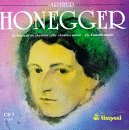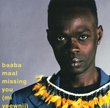| All Artists: Honegger, Devoyon, Wallflisch Title: Sonatina for Clarinet & Piano / Rapsodie Members Wishing: 1 Total Copies: 0 Label: Timpani Release Date: 4/15/2000 Album Type: Import Genres: Pop, Classical Styles: Vocal Pop, Opera & Classical Vocal, Chamber Music, Historical Periods, Classical (c.1770-1830), Instruments, Brass, Reeds & Winds Number of Discs: 1 SwapaCD Credits: 1 UPCs: 750582436727, 3377891310103 |
Search - Honegger, Devoyon, Wallflisch :: Sonatina for Clarinet & Piano / Rapsodie
 | Honegger, Devoyon, Wallflisch Sonatina for Clarinet & Piano / Rapsodie Genres: Pop, Classical
|
Larger Image |
CD DetailsSimilar CDsSimilarly Requested CDs |
Member CD ReviewsReviewed on 5/29/2008... "Honegger is one of the 20th century's great composers, yet all too few people are aware of this. To most music lovers he will be known as a member of the group of composers called Les Six, who wrote a piece called Pacific 231 which was inspired by an express steam locomotive. While all this is true, it is also misleading. For Honegger is a significant figure, wide ranging in style, committed in approach, and not at all a figure whose style is consistent with the frivolous world of Les Six.
In fact after 1920 Honegger moved away from the aesthetic of Les Six, and he unequivocally stated his preference for 'chamber music in its most serious and austere form'. Therefore the present collection of chamber music miniatures is a fascinating insight into his personality. Much of the music dates from early in Honegger's career, at the time when his association with Jean Cocteau and Les Six was continuing. But in these smaller pieces, often written without regard to publication or performance, he was very much 'his own man'. The best known item here is the Danse de la Chèvre (Dance of the Goat) (TRACK 5: 0.00), which after Debussy's Syrinx is perhaps the most frequently performed music for the unaccompanied flute. Its atmospheric slow introduction and lively principal dance section make for compelling listening, particularly when the playing and recording are so fine. The recordings date from 1991, and were made with the composer's centenary (1992) in mind. The remasterings by Timpani have done Honegger proud, and there is a good balance of detail and atmosphere, without the over-ample acoustic which so often detracts from performances in churches. The entire range of Honegger's creative life is represented, not simply his earlier years, and there is a particular emphasis on music featuring the flute, an instrument for which Honegger wrote particularly well (think of the finale of the Symphonie Liturgique, one of the greatest 20th century symphonies). Some of Honegger's early music made an immediate impression, and judging by the Rapsodie for 2 flutes, clarinet & piano (1917) (TRACK 4: 0.00) it is easy to understand why. The slow introduction, clearly influenced by Debussy, is a beautiful evocation. Even the brief pieces for brass and piano work well, and have their own distinctive characters, as well as interesting background stories. These are outlined in the masterly insert notes by Harry Halbreich, the world's leading Honegger scholar. But for a real flavour of Honegger's sensitivity, the Chanson de Ronsard (1924) (TRACK 18: 0.00) seems hard to beat. The song is barely 90 seconds long, yet it has a rare beauty that really does make this repertoire worth exploring." -Terry Barfoot (www.musicweb-international.com) |

 Track Listings (21) - Disc #1
Track Listings (21) - Disc #1

